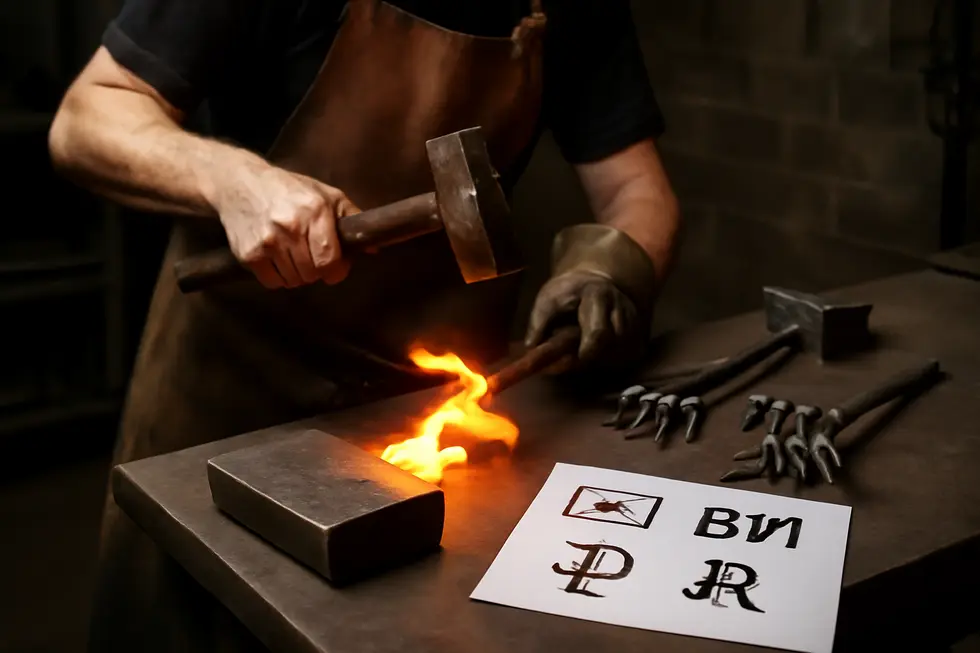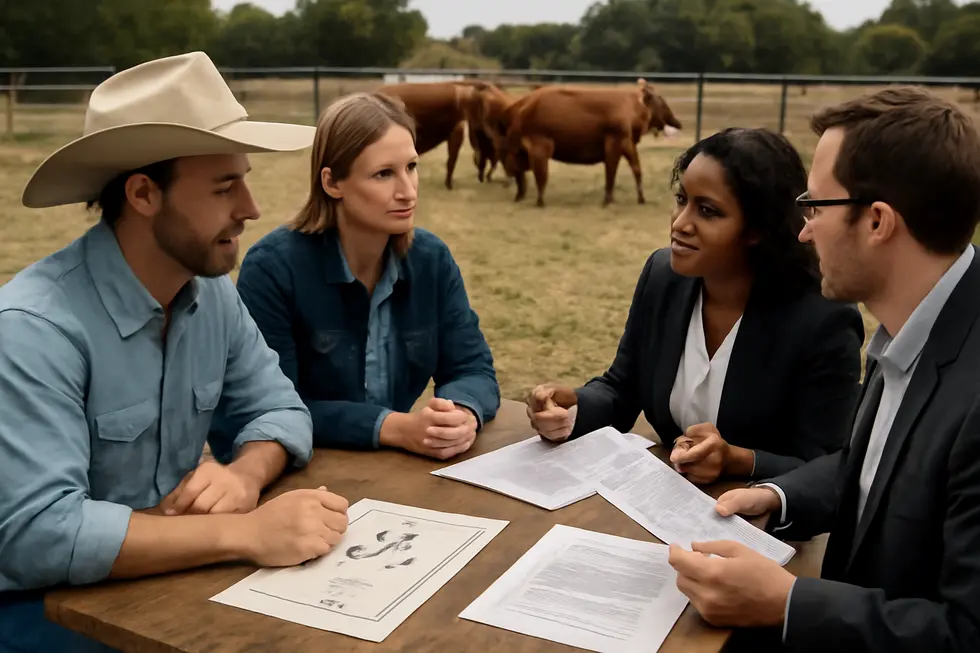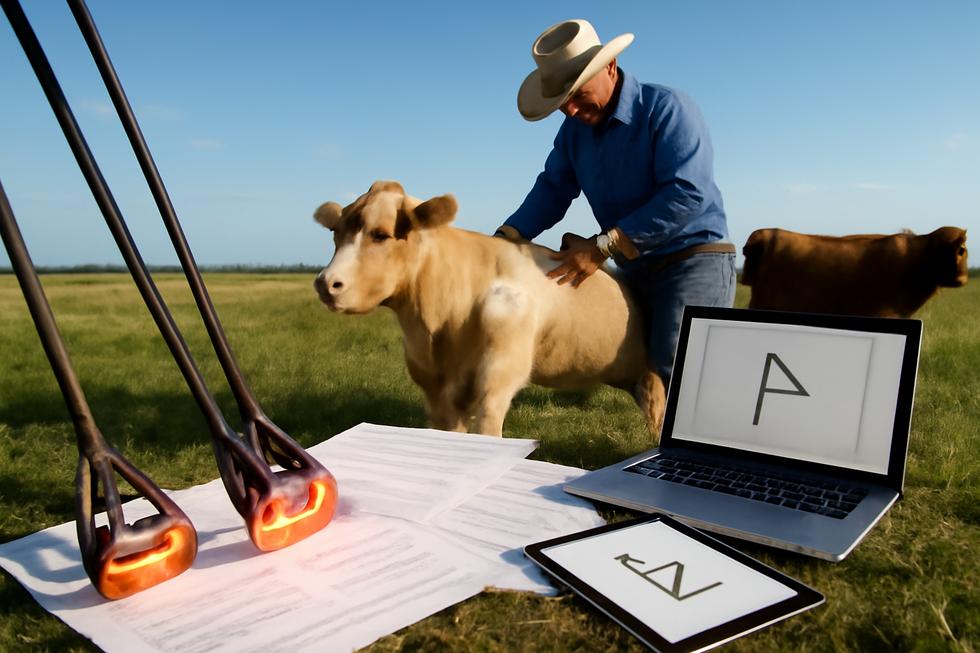Introduction
Securing a cattle brand is a fundamental step for business owners involved in livestock management, ensuring clear ownership and safeguarding investments. A cattle brand represents not just your property but also your identity in the agricultural marketplace. This comprehensive guide outlines the critical steps to get a legally recognized cattle brand, beginning with crafting a unique design that distinguishes your livestock distinctly. It then explores navigating the registration procedures that differ regionally, ensuring compliance and legal protection. For those without existing designs, commissioning custom branding and manufacturing personalized branding irons is covered, highlighting best practices. Finally, the guide clarifies legal rights, correct usage, and adherence to regulations to maximize the benefits of your cattle brand. Together, these chapters provide a thorough understanding essential to establishing and maintaining a cattle brand that upholds your business’s integrity and security.
Tables of Contents
Chapter 1: How to Get a Cattle Brand: Designing a Unique and Legally Acceptable Mark
- Crafting a Distinctive and Compliant Cattle Brand Design
- Understanding Legal Frameworks to Secure Your Unique Cattle Brand
- Mastering the Application and Registration Journey for Your Cattle Brand
- Navigating Legal Compliance and Brand Inspection to Secure Your Cattle Mark
Chapter 2: How to Get a Cattle Brand: Navigating Registration Processes Across Different Jurisdictions
- Key Legal Steps to Secure Your Cattle Brand Across State Lines
- Mastering the Cattle Brand Application: Essential Steps to Ensure Legal Registration and Ownership
- Regional and State Variations in Cattle Brand Registration: Understanding Jurisdictional Nuances
- Understanding the Societal and Economic Impacts of Cattle Brand Registration Across Jurisdictions
Chapter 3: How to Get a Cattle Brand: Commissioning a Custom Design and Manufacturing Branding Irons
- Crafting a Unique Cattle Brand: From Custom Design to Official Registration and Branding Iron Production
- Securing Government Approval and Completing Payment to Bring Your Custom Cattle Brand to Life
- Crafting Distinctive Branding Irons: Balancing Custom Design with Legal Standards for Your Cattle Brand
- Transforming Your Registered Cattle Brand into a Custom Branding Iron and Its Essential Role in Ownership
Chapter 4: How to Get a Cattle Brand: Legal Rights, Usage, and Compliance Requirements
- Securing Exclusive Ownership: The Essential Registration Process for Your Cattle Brand
- Navigating Usage Rules and State-Specific Compliance for Cattle Branding
- Securing a Distinctive Cattle Brand: Steps to Ensure Legal Uniqueness and Ownership Protection
- Ensuring Legal Ownership: Inspections, Documentation, and Transfer Protocols for Cattle Brands
Chapter 1: How to Get a Cattle Brand: Designing a Unique and Legally Acceptable Mark

1. Crafting a Distinctive and Compliant Cattle Brand Design
Creating a cattle brand involves more than artistic creativity—it must be legally distinctive and compliant with regional regulations. A brand serves as a permanent mark of ownership, so it must be an unmistakable symbol or combination of letters and numbers that sets your livestock apart. Avoid designs identical or confusingly similar to existing brands in your jurisdiction to prevent disputes and ensure clear identification. Typically, cattle brands must meet minimum size requirements—often around three inches in height—to be clearly visible once applied.
The design process demands simplicity and clarity; overly complex or intricate marks may not transfer well onto animals or pass inspection. Orientation matters as well, with designs usually read left to right and top to bottom. Once a draft is prepared, it must be submitted to the appropriate state or regional livestock authority—such as a Department of Agriculture or Brand Inspection Office—for official approval. If the brand meets all distinctiveness and size criteria, a certificate of ownership is issued, granting legal protection and the exclusive right to use the brand.
Legal restrictions prohibit using unregistered brands or those resembling existing marks. Brand inspections help enforce this, especially during animal transfers or sales. For guidance on protecting unique marks and understanding related intellectual property nuances, see more about trademark protections for business ownership online. Overall, designing your cattle brand with these principles ensures it is both a practical livestock identifier and a secure legal asset.
2. Understanding Legal Frameworks to Secure Your Unique Cattle Brand
Legally acquiring a cattle brand requires careful navigation of regional rules to ensure your mark is distinctive and formally recognized. The process starts with designing a brand that clearly differs from all registered marks within your jurisdiction, avoiding confusion and ownership conflicts. Once you finalize a design, you must submit a detailed application to the designated authority, such as a county clerk or secretary of state office, including a precise image of your brand and your personal information. Depending on local laws, some regions mandate public notification of your intent to register the brand, providing an opportunity for objections if similarities to existing brands arise. Approval leads to official recording, assignment of a brand identification number, and specification of lawful branding locations on your cattle. It is critical to comply with these placement regulations, as misuse can constitute illegal marking. Variation in requirements across states—like Michigan’s secretary of state filing or Texas’s county-based registration—makes consulting local livestock laws essential for a successful application. This legal framework is fundamental to protecting your property rights and preventing disputes. For a more comprehensive understanding of trademark protection applicable to your business ventures, including branding, you may find guidance by exploring common trademark legal principles.
3. Mastering the Application and Registration Journey for Your Cattle Brand
Crafting and safeguarding ownership through cattle brands requires a precise application and registration process. This journey begins with creating a distinctive brand—a unique symbol or combination of letters and marks tailored to your livestock. Numerals or common ear notches are excluded to avoid confusion with other identification methods. Once your mark is designed, the next step is submitting a formal application to the relevant state or regional livestock authority, often a department of agriculture or brand inspector. This involves presenting a clear facsimile of your brand along with the required fee, either by physical mail or electronic submission, depending on local regulations.
Authorities then meticulously review your submission to confirm your brand’s uniqueness within their jurisdiction, ensuring it does not resemble an existing mark. This careful vetting prevents disputes and protects the legitimacy of your ownership. If approved, the brand is officially recorded, and you receive a certificate evidencing your legal right to use the brand on your cattle. Several regions may impose requirements for periodic renewal or rerecording, maintaining your brand’s validity over time.
Additionally, brand inspection is a crucial step when ownership changes or animals move, verifying the cattle carry the authorized mark. These steps collectively ensure your brand stands as a secure, legally recognized symbol of your livestock. For further detail on managing intellectual property broadly, exploring resources on trademark protections can provide valuable insights into protecting your brand identity effectively.
4. Navigating Legal Compliance and Brand Inspection to Secure Your Cattle Mark
Creating a legally acceptable cattle brand requires more than just a creative design; it demands strict adherence to state-specific regulations that protect ownership rights and ensure clarity in livestock identification. The brand must be unmistakably unique within its jurisdiction, avoiding any resemblance that could cause confusion—Ohio, for instance, enforces this rigorously to prevent disputes. Once designed, the brand undergoes official recording with the appropriate state authority, such as an agriculture department or brand division, which verifies the mark and issues a certificate establishing ownership. States often prescribe minimum size and precise placement requirements to standardize branding practices; Ohio mandates a minimum three-inch height, while Arizona strictly controls where the brand can be applied. Beyond registration, brand inspection plays a pivotal role in verifying ownership during livestock sales, transport, or slaughter. These inspections, usually coordinated and paid for by the seller, act as legal safeguards against theft and misidentification. Failure to comply with inspection rules can result in fines or legal penalties, underscoring the necessity of full compliance. Brand inspectors serve as official agents enforcing these regulations, thus preserving the integrity of cattle branding systems. This comprehensive process—from unique design and official recording to adherence to inspection protocols—forms the backbone of legally sound livestock ownership. For more detailed guidelines on brand design and registration compliance, reviewing resources like the Ohio Livestock Brands Administrative Code can provide invaluable insight. Additionally, understanding trademark protections can be relevant when considering your brand, so exploring information on trademark protection for business names and logos may offer useful parallels.
Chapter 2: How to Get a Cattle Brand: Navigating Registration Processes Across Different Jurisdictions

1. Key Legal Steps to Secure Your Cattle Brand Across State Lines
Obtaining legal recognition for your cattle brand involves a formal registration process tailored to your jurisdiction’s regulations. Central to this process is submitting a distinct brand design to the relevant livestock authority, typically at a state or county level, ensuring no duplication or confusion with existing brands. Many regions require you to advertise your intent publicly, often through state bulletins or newspapers, allowing others to voice objections and protect established ownership rights. Fees for registration and sometimes regular renewals apply, such as Nevada’s five-year brand re-recording requirement. Beyond initial registration, strict rules govern how and where the brand may be applied on the animal to preserve its legal validity. Transferring brand ownership demands documented sales records, sometimes notarized and recorded with authorities, to maintain clear ownership chains. Additionally, jurisdictions like Idaho and Nevada impose mandatory brand inspections before cattle movement across districts or sale, thus preventing theft and verifying rightful possession. These layered regulations affirm that your brand is not just a mark but a protected legal asset, ensuring your livestock ownership is clearly recognized and defended. Understanding these legal frameworks is essential to navigate the registration processes effectively and safeguard your rights. For further insights on intellectual property protection related to branding, explore resources on trademark protection for business names and logos.
2. Mastering the Cattle Brand Application: Essential Steps to Ensure Legal Registration and Ownership
Obtaining a legally recognized cattle brand involves a carefully structured application process that varies by jurisdiction but shares fundamental steps. Begin by thoroughly researching the local livestock authority’s brand registration requirements, which include guidelines on brand design, location, fees, and submission formats. This research also involves verifying that your chosen brand is unique to prevent conflicts that could delay approval.
Once your brand design adheres to the regulations, you must submit an application that details your personal or business information, a clear rendering of the brand, and the intended branding location on your cattle. This formality often requires paying a registration fee and may include supplementary documents, such as declarations tied to livestock movement and ownership.
After submission, the authority reviews the application comprehensively to confirm the brand’s distinctiveness and regulatory compliance. Some regions may conduct inspections or hearings to resolve disputes or clarify details. Upon approval, you receive a certificate that legally affirms your ownership of the brand.
Using the brand strictly according to the registration—on your own livestock and in the prescribed manner—is critical to maintaining legal protection. Maintaining accurate records and renewing the registration when required ensures ongoing compliance. For ranchers seeking additional protection, pursuing trademark registration alongside brand registration can safeguard business identity more robustly.
Consulting your state or territory’s livestock brand registry and their application materials is integral to navigating this process smoothly. This careful approach guarantees your cattle brand is effectively protected under the law, supporting ownership clarity and livestock management best practices.
3. Regional and State Variations in Cattle Brand Registration: Understanding Jurisdictional Nuances
Obtaining a cattle brand requires navigating various registration procedures that differ notably across states and regions. Each jurisdiction assigns a specific authority responsible for registering brands, such as the Secretary of State in Michigan or county clerks in Texas, highlighting the localized nature of cattle branding laws. The application process also varies; for example, Arizona mandates public advertisement of proposed brands to allow objections, whereas Ohio requires central approval to prevent confusing similarities with existing brands. These steps ensure each brand’s uniqueness, safeguarding ranchers from ownership disputes.
Branding methods allowed differ as well. Michigan restricts branding strictly to traditional hot irons, excluding earmarks and tattoos, while Texas permits multiple identification methods including electronic devices. Age requirements for marking cattle apply in some areas; Texas insists cattle must be marked by their first birthday. Additionally, usage rules state brands must be applied exactly as approved in specific locations on the animal. Nevada incorporates brand inspections to enforce compliance with state statutes.
Understanding these jurisdictional nuances is essential to legally secure and effectively use a cattle brand. Consulting local agricultural authorities and reviewing respective statutes helps ranchers align their branding practices with legal mandates. This careful adherence not only protects ownership rights but also promotes consistent livestock identification within the industry. For a deeper grasp of legal protections relevant to branding, exploring guidance on trademark rights offers valuable insight.
4. Understanding the Societal and Economic Impacts of Cattle Brand Registration Across Jurisdictions
Obtaining a registered cattle brand extends beyond legal formality; it deeply influences both economic viability and community dynamics. Registration secures undeniable proof of livestock ownership, which is essential for smooth sales, auctions, and interstate transfers, enhancing market access and reducing transactional disputes. Legally recognized brands shield owners against theft and fraudulent claims, minimizing costly conflicts and losses. Yet, these protections come with notable costs—registration fees, inspections, and compliance demands can strain ranchers, especially those operating across multiple regulatory environments with differing requirements.
Socially, brand registration fosters trust and transparency within livestock communities, reducing conflicts over ownership and supporting orderly management. Brand inspections, often paired with animal health monitoring, also reinforce vital disease control measures and agricultural biosecurity, safeguarding broader public health. Additionally, branding carries cultural weight in many regions, symbolizing ranching traditions and identity.
Variation in regulations complicates registration: design rules, submission methods, and enforcement protocols differ widely by state or territory. Navigating this patchwork demands careful attention to each jurisdiction’s laws to maintain compliance and avoid penalties.
Overall, registering a cattle brand builds a foundation for safe livestock commerce and community trust, while requiring awareness of the administrative and financial efforts involved. For deeper insights into regulatory demands, resources such as the Ohio Department of Agriculture’s livestock brand guidelines offer valuable direction. More about these processes can be found in this guide for comprehensive cattle brand registration.
Chapter 3: How to Get a Cattle Brand: Commissioning a Custom Design and Manufacturing Branding Irons

1. Crafting a Unique Cattle Brand: From Custom Design to Official Registration and Branding Iron Production
Creating a cattle brand begins with designing a distinctive mark that clearly identifies your livestock while avoiding duplication. This mark can combine letters, numbers, and symbols but must comply with your jurisdiction’s regulations to ensure uniqueness and legal acceptance. Once your design is complete, the next step is to submit it to your local livestock or agricultural authority for evaluation. The submission process varies—some regions like Queensland require email applications and fee payment methods such as BPoint, while others, such as Ohio and Texas, have their own specific registration procedures with certificates issued upon approval. During the review period, officials check for similarities with existing brands to prevent ownership disputes.
After receiving official approval and legal registration, you can commission a manufacturer to create a custom branding iron matching your registered design. This iron is then used to mark cattle according to established regional standards, ensuring both legality and animal welfare compliance. It is crucial to only apply the brand after formal registration and to adhere to any age or method restrictions set by your jurisdiction. This thorough process not only builds a secure link between your livestock and your ownership but also safeguards your interests from legal challenges. For additional guidance on registration, refer to resources like the comprehensive cattle brand registration guide.
2. Securing Government Approval and Completing Payment to Bring Your Custom Cattle Brand to Life
Once you have crafted a unique and legally compliant cattle brand design, the next vital step is to secure official approval from the relevant government authority. This process ensures your brand is distinctive and prohibits duplication by other livestock owners, protecting your ownership rights. Typically, you will submit your design—often digitally or by mail—to a state Department of Agriculture or specialized Brand Inspection Office. Agencies rigorously review submissions for uniqueness and adherence to size and marking standards, such as minimum dimensions or restrictions on similar shapes. After approval, the approved brand is entered into a central registry, and you receive a certificate of ownership, which serves as your legal proof.
Concurrently, most jurisdictions require payment of registration fees, which vary but may include costs for application processing and record maintenance. These fees are generally paid at the time of submission. Following approval, commissioning a custom branding iron becomes possible. This step involves choosing a reputable manufacturer skilled in producing irons from the approved design, and paying for fabrication separately. Maintaining thorough documentation of your brand registration and iron purchase is essential for lawful branding, livestock transfers, and compliance inspections. Adhering to these government-mandated steps safeguards your brand’s legal standing and empowers you to mark your cattle confidently.
For comprehensive guidance on state-specific requirements and processes, visiting the official agricultural department websites provides invaluable resources and forms tailored to your region. This coordination between design approval, payment, and manufacturing ensures you meet all legal criteria to bring your custom cattle brand into use.
For more information about livestock brand protections and regulations, explore resources such as cattle brand registration guides.
3. Crafting Distinctive Branding Irons: Balancing Custom Design with Legal Standards for Your Cattle Brand
Securing a cattle brand begins with commissioning a custom design that is both distinctive and compliant with legal frameworks. This process often involves collaborating with artisans or manufacturers who specialize in crafting robust branding irons tailored to the unique logo or symbol you’ve created. These irons are commonly forged from durable steel to withstand repeated heating and use in harsh ranch environments. Designs may range from simple to intricate, but must be feasible for manufacturing without compromising clarity or durability.
Before production, it’s essential to confirm that your design meets jurisdictional legal criteria, including size, shape, and distinctiveness, thus avoiding conflicts with existing registered marks. Once the design is finalized and the iron produced, registering your brand with the local livestock authority ensures your ownership rights are protected and recognized by law.
The crafted branding iron then becomes an indispensable tool for marking livestock following regional regulations, such as placement and timing of branding. Paying attention to these legal nuances prevents disputes and establishes clear proof of ownership. For those unfamiliar with design or legal specifics, consulting with ranch branding experts and agricultural departments is advised to guide both the creative and compliance aspects.
For more insight into protecting unique marks and navigating legal registrations, exploring trademark protection for business names and logos can offer valuable guidance applicable to cattle branding scenarios.
4. Transforming Your Registered Cattle Brand into a Custom Branding Iron and Its Essential Role in Ownership
Once your uniquely designed cattle brand receives official approval and registration, the next critical step is commissioning a custom branding iron crafted precisely to your registered mark. This specialized tool transforms your legal ownership symbol into a physical instrument for marking livestock, serving as a permanent, recognizable sign of ownership. Branding irons are carefully manufactured from durable metals to endure high heat, ensuring clear and lasting impressions on cattle hides.
Commissioning begins by submitting your approved design to a branding iron manufacturer who replicates it exactly, respecting the unique shapes and proportions required to match your registration. With the branding iron in hand, you can mark your cattle in compliance with regional laws, which often mandate branding before livestock sales or transfers to confirm ownership and deter theft.
The practical use of your custom brand extends beyond identification; it supports effective herd management and legal proof during transactions. Different jurisdictions may impose specific requirements on branding methods and timing—for example, Queensland requires branding before sale, while Texas mandates marking by the time cattle reach one year old. Humane and safe application of branding irons is vital to minimize animal distress and meet regulatory standards.
Maintaining records of your registered brand and branding activities is essential for resolving ownership disputes and facilitating livestock commerce. By completing this process, your cattle brand becomes an indispensable tool linking your legal rights to physical identification in the field. For further details on cattle brand registration rules and design considerations, consult authoritative sources like the cattle brand registration guides.
Chapter 4: How to Get a Cattle Brand: Legal Rights, Usage, and Compliance Requirements

1. Securing Exclusive Ownership: The Essential Registration Process for Your Cattle Brand
Establishing legal ownership of a cattle brand begins with registering a unique and distinctive mark with the relevant state or local livestock authority. This vital step grants exclusive rights to use your brand on cattle within that jurisdiction, helping prevent disputes and unauthorized use. The registration process requires submitting a clear representation of your brand design along with the intended location for branding on the animal — such as the shoulder, hip, or rib. This specificity ensures that no duplicate or confusingly similar mark can be registered, preserving the uniqueness of each brand.
Accompanying your application, you must pay registration fees that vary by region. Upon review by the authority, your brand is either approved and recorded in an official registry or returned for revision if it conflicts with existing brands. Receiving a certificate of ownership formalizes your exclusive rights, providing legal verification of your claim.
Beyond registration, many states mandate brand inspections to confirm rightful ownership during cattle sales, transport, or slaughter, enhancing traceability and protection. Procedures and offices responsible for brand registration differ regionally; for instance, Ohio centralizes this through its Department of Agriculture, while Texas involves county clerks who interface with broader livestock commissions.
For livestock owners seeking broader protection, distinguishing cattle branding from trademarks is important: a brand identifies the physical animal, whereas trademarks safeguard business names or logos. For further legal understanding and detailed brand registration guidelines, exploring resources on brand-related rights such as trademark protection can be valuable.
2. Navigating Usage Rules and State-Specific Compliance for Cattle Branding
Obtaining a cattle brand means more than creating a unique mark; it requires precise adherence to usage guidelines and compliance mandates unique to each jurisdiction. Your brand becomes your legal sign of ownership, but states enforce strict rules to avoid confusion and ensure proper livestock identification.
First, your brand design must be distinctly different from all others recorded in your state to prevent disputes. Once registered with the designated agency—often the state’s department of agriculture or county clerk—legal ownership rights are granted. This process usually requires submitting a clear facsimile of the brand, an application, and paying a fee. Brand use must follow authorized methods such as hot iron or freeze branding, respecting state-approved techniques.
Placement and size requirements vary greatly. For instance, Ohio mandates brands be at least three inches tall, while Texas requires cattle to be branded or earmarked by the animal’s first birthday. In Texas, brands are recorded at the county level and electronically shared with state authorities for full regulatory compliance. Some states, like Wisconsin, require periodic rerecording of the brand to maintain exclusive rights.
Because branding often forms part of broader livestock business compliance, understanding these detailed regulations safeguards your investment and legal claim. For tailored guidelines and registration procedures, always consult your local livestock authority or agricultural department. For deeper insight on protecting your livestock identity and rights, explore authoritative information on cattle brand registration regulations.
3. Securing a Distinctive Cattle Brand: Steps to Ensure Legal Uniqueness and Ownership Protection
Creating a cattle brand that is both unique and legally recognized demands careful preparation and adherence to regional regulations. The cornerstone of this process lies in designing a mark that is visually distinctive, avoiding any resemblance or confusion with existing brands in your jurisdiction. This uniqueness is non-negotiable since authorities conduct thorough reviews of all applications to prevent disputes over livestock ownership.
Once you have crafted a unique design, the next step is to formally submit an application to the appropriate livestock or agricultural authority. This typically involves providing a clear facsimile of the brand and paying the required fees. Submission methods may vary; for example, some areas accept electronic applications, while others require physical filings. Awaiting approval can take weeks, during which your design is checked against databases of registered brands to confirm exclusivity.
Only upon receiving official certification is a brand authorized for use. This legal recognition grants exclusive rights and helps avoid conflicts with other livestock owners. Additionally, many regions enforce strict rules around the placement of the brand on animals, and some require periodic renewal of registration to maintain the brand’s validity.
Professional design services can streamline this process by creating clear, standardized brand images that meet registration criteria. Following these steps ensures your cattle brand remains a protected symbol of ownership, supported by legal safeguards that prevent infringement or confusion.
For more detailed guidance on navigating these legal protections and the registration process, exploring resources on trademark and brand registration for businesses can be particularly insightful.
4. Ensuring Legal Ownership: Inspections, Documentation, and Transfer Protocols for Cattle Brands
Securing a cattle brand involves more than just designing and registering a unique mark; it requires strict adherence to inspection, documentation, and transfer protocols to guarantee legal protection and ownership clarity. After registering your brand with the appropriate state agency, you must participate in mandatory brand inspections. These inspections, common in states like Nevada and Idaho, are essential before transporting cattle across districts, changing ownership, or sending animals to slaughter. Failure to obtain a proper brand inspection certificate can lead to fines or legal penalties, emphasizing its critical role in livestock management.
When cattle change hands, the transaction must be carefully documented. This includes obtaining a valid bill of sale and a brand inspection certificate verifying ownership transfer. Some states, such as Texas, require recording these transfers with a county clerk who coordinates with agricultural authorities to maintain up-to-date brand registries. These procedures prevent disputes and help combat cattle theft by ensuring that every animal’s brand is tracked and legally recognized.
Brands often need periodic renewal, with Nevada mandating renewal every five years to keep the brand valid. Furthermore, humane branding methods and inspector appointments by state agriculture departments help enforce compliance while preserving animal welfare. Understanding and following these layered compliance steps safeguards your investment, protecting your cattle’s identity through official records and inspections. For detailed guidance, always consult your state’s Department of Agriculture or Brand Office.
For additional insights on protecting your brand identity beyond livestock, consider exploring comprehensive resources on trademark protection for your business.
Final thoughts
Obtaining a cattle brand is a strategic business decision that extends beyond mere livestock identification. By designing a distinctive and legally acceptable mark, navigating the registration protocols of your jurisdiction, commissioning custom branding tools, and understanding the legal parameters surrounding usage, business owners can safeguard their valuable assets effectively. A registered cattle brand not only prevents ownership disputes but also serves as a key to maintaining accountability and trust in the livestock trade. Mastery of each step builds a foundation for secure ownership and regulatory compliance, fortifying your position in the agricultural sector.
Your IP is the foundation of your success – let’s protect it together before it’s too late. We can’t wait to help you turn your ideas into legally secured assets.
About us
undefined



I don’t think the title of your article matches the content lol. Just kidding, mainly because I had some doubts after reading the article.